Recovery of Acid and Alkaline from Industrial Saline Wastewater by Bipolar Membrane Electrodialysis under High-Chemical Oxygen Demand Concentration
Abstract
:1. Introduction
2. Results and Discussion
2.1. Comparative Analysis of Two Types of BMED Membrane Stacks
2.1.1. Comparative Analysis of Electrolytic Salt Rates of Different BMED Membrane Stacks
2.1.2. Comparative Analysis of Acid and Alkali Production Rates of Different BMED Membrane Stacks
2.1.3. Comparative Analysis of Energy Consumption per Unit Mass of Different BMED Membrane Stacks
2.1.4. Comparative Analysis of the Economics of ACID-Alkali Production from Electrolytic Salt of Different BMED Membrane Stacks
2.2. Effect of High COD Saline Wastewater on the Performance of BMED Membrane Stacks
2.2.1. Effect of High COD Saline Wastewater on Electrolytic Salt Performance
2.2.2. Effect of High COD Saline Wastewater on the Acid and Alkali Production Rates of Industrial High Saline Wastewater
2.2.3. Effect of High COD Saline Wastewater on Energy Consumption Per Unit Mass of BMED System
2.3. The Possible Mechanism Analysis
3. Material and Method
3.1. Materials
3.2. Experiments
3.2.1. BMED Membrane Stacks under Standard Brine
3.2.2. The BMED Treatment of Salinity Wastewater under High COD Concentration
3.3. Data Analysis
4. Conclusions
Author Contributions
Funding
Institutional Review Board Statement
Informed Consent Statement
Data Availability Statement
Acknowledgments
Conflicts of Interest
Sample Availability
References
- He, K.; Liu, D.; Zhang, H.; Zhang, S. Application of homogeneous membrane electrodialysis in the treatment of high-salt organic wastewater. IOP Conf. Ser. Earth Environ. Sci. 2019, 227, 062043. [Google Scholar] [CrossRef]
- Sudarno, U.; Bathe, S.; Winter, J.; Gallert, C. Nitrification in fixed-bed reactors treating saline wastewater. Appl. Microbiol. Biotechnol. 2009, 85, 2301–2304. [Google Scholar] [CrossRef] [PubMed] [Green Version]
- Chen, G.; Liu, R.; Shon, H.K.; Wang, Y.; Song, J.; Li, X.; He, T. Open porous hydrophilic supported thin-film composite forward osmosis membrane via co-casting for treatment of high-salinity wastewater. Desalination 2017, 405, 76–84. [Google Scholar] [CrossRef]
- Lu, K.; Yang, L.; Bai, Y.; Zhang, J.; Bie, N.; Ren, Y.; Ma, Y. Experimental investigation and theoretical modeling on scale behaviors of high salinity wastewater in zero liquid discharge process of coal chemical industry. Chin. J. Chem. Eng. 2020, 28, 11. [Google Scholar] [CrossRef]
- Bauer, B.; Gerner, F.J.; Strathmann, H. Development of bipolar membranes. Desalination 1988, 68, 279–292. [Google Scholar] [CrossRef]
- Liu, G.; Luo, H.; Wang, H.; Wang, B.; Zhang, R.; Chen, S. Malic Acid Production Using a Biological Electrodialysis with Bipolar Membrane. J. Membr. Sci. 2014, 471, 179–184. [Google Scholar] [CrossRef]
- Pärnamäe, R.; Mareev, S.; Nikonenko, V.; Melnikov, S.; Sheldeshov, N.; Zabolotskii, V.; Hamelers, H.V.M.; Tedesco, M. Bipolar Membranes: A Review on Principles, Latest Developments, and Applications. J. Membr. Sci. 2021, 617, 118538. [Google Scholar] [CrossRef]
- Wiśniewski, J.; Wiśniewska, G.; Winnicki, T. Application of bipolar electrodialysis to the recovery of acids and alkalis from water solutions. Desalination 2004, 169, 11–20. [Google Scholar] [CrossRef]
- Lv, Y.; Wu, S.; Liao, J.; Qiu, Y.; Dong, J.; Liu, C.; Ruan, H.; Shen, J. An integrated adsorption- and membrane-based system for high-salinity aniline wastewater treatment with zero liquid discharge. Desalination 2022, 527, 115537. [Google Scholar] [CrossRef]
- Mohammadi, M.; Guo, H.; Yuan, P.; Pavlovic, V.; Barber, J.; Kim, Y. Ammonia separation from wastewater using bipolar membrane electrodialysis. Electrochem. Sci. Adv. 2021, 1, e2000030. [Google Scholar] [CrossRef]
- Hussain, A.; Yan, H.; Ul Afsar, N.; Jiang, C.; Wang, Y.; Xu, T. Multistage-batch bipolar membrane electrodialysis for base production from high-salinity wastewater. Front. Chem. Sci. Eng. 2021, 16, 764–773. [Google Scholar] [CrossRef]
- Jaime-Ferrer, J.S.; Couallier, E.; Durand, G.; Rakib, M. Three compartment bipolar membrane electrodialysis of sodium formate. J. Membr. Sci. 2008, 325, 528–536. [Google Scholar] [CrossRef] [Green Version]
- Molnár, E.; Nemestóthy, N.; Bélafi-Bakó, K. Utilisation of bipolar electrodialysis for recovery of galacturonic acid. Desalination 2010, 250, 1128–1131. [Google Scholar] [CrossRef]
- Zhang, K.; Wang, M.; Wang, D.; Gao, C. The energy-saving production of tartaric acid using ion exchange resin-filling bipolar membrane electrodialysis. J. Membr. Sci. 2009, 341, 246–251. [Google Scholar] [CrossRef]
- Shee, F.; Bazinet, L. Cationic balance and current efficiency of a three-compartment bipolar membrane electrodialysis system during the preparation of chitosan oligomers. J. Membr. Sci. 2009, 341, 46–50. [Google Scholar] [CrossRef]
- Sun, Y.; Wang, Y.; Peng, Z.; Liu, Y. Treatment of high salinity sulfanilic acid wastewater by bipolar membrane electrodialysis. Sep. Purif. Technol. 2021, 281, 1199842. [Google Scholar] [CrossRef]
- Yuzer, B.; Selcuk, H. Recovery of Biologically Treated Textile Wastewater by Ozonation and Subsequent Bipolar Membrane Electrodialysis Process. Membranes 2021, 11, 900. [Google Scholar] [CrossRef] [PubMed]
- Achoh, A.; Zabolotsky, V.; Melnikov, S. Conversion of water-organic solution of sodium naphtenates into naphtenic acids and alkali by electrodialysis with bipolar membranes. Sep. Purif. Technol. 2018, 212, 929–940. [Google Scholar] [CrossRef]
- Tong, T.; Elimelech, M. The Global Rise of Zero Liquid Discharge for Wastewater Management: Drivers, Technologies, and Future Directions. Environ. Sci. Technol. 2016, 50, 6846–6855. [Google Scholar] [CrossRef]
- Gurreri, L.; Tamburini, A.; Cipollina, A.; Micale, G. Electrodialysis Applications in Wastewater Treatment for Environmental Protection and Resources Recovery: A Systematic Review on Progress and Perspectives. Membranes 2020, 10, 146. [Google Scholar] [CrossRef] [PubMed]
- Zhang, X.; Li, C.; Wang, Y.; Luo, J.; Xu, T. Recovery of acetic acid from simulated acetaldehyde wastewaters: Bipolar membrane electrodialysis processes and membrane selection. Fuel Energy Abstr. 2011, 379, 184–190. [Google Scholar] [CrossRef]
- Wei, Y.; Li, C.; Wang, Y.; Zhang, X.; Li, Q.; Xu, T. Regenerating sodium hydroxide from the spent caustic by bipolar membrane electrodialysis (BMED). Sep. Purif. Technol. 2012, 86, 49–54. [Google Scholar] [CrossRef]
- Öner, M.R.; Kanca, A.; Ata, O.N.; Yapıcı, S.; Yaylalı, N.A. Bipolar Membrane Electrodialysis for Mixed Salt Water Treatment: Evaluation of parameters on process performance. J. Environ. Chem. Eng. 2021, 9, 105750. [Google Scholar] [CrossRef]
- Meng, W.; Wang, G.; Zhang, M.; Wan, D.; Song, N.; Lei, Y.; Cheng, J.; Qu, W.; Lee, S. Generation of Acid-Base by Bipolar Membrane Electrodialysis Process during Desalination of Pesticide Containing Wastewater. DWT 2021, 217, 91–100. [Google Scholar] [CrossRef]
- Lv, Y.; Yan, H.; Yang, B.; Wu, C.; Zhang, X.; Wang, X. Bipolar membrane electrodialysis for the recycling of ammonium chloride wastewater: Membrane selection and process optimization. Chem. Eng. Res. Des. 2018, 138, 105–115. [Google Scholar] [CrossRef]
- Li, Y.; Shi, S.; Cao, H.; Wu, X.; Zhao, Z.; Wang, L. Bipolar Membrane Electrodialysis for Generation of Hydrochloric Acid and Ammonia from Simulated Ammonium Chloride Wastewater. Water Res. 2016, 89, 201–209. [Google Scholar] [CrossRef]
- Qiu, Y.; Lv, Y.; Tang, C.; Liao, J.; Ruan, H.; Sotto, A.; Shen, J. Sustainable Recovery of High-Saline Papermaking Wastewater: Optimized Separation for Salts and Organics via Membrane-Hybrid Process. Desalination 2021, 507, 114938. [Google Scholar] [CrossRef]
- Lindstrand, V.; Sundström, G.; Jönsson, A.-S. Fouling of Electrodialysis Membranes by Organic Substances. Desalination 2000, 128, 91–102. [Google Scholar] [CrossRef]
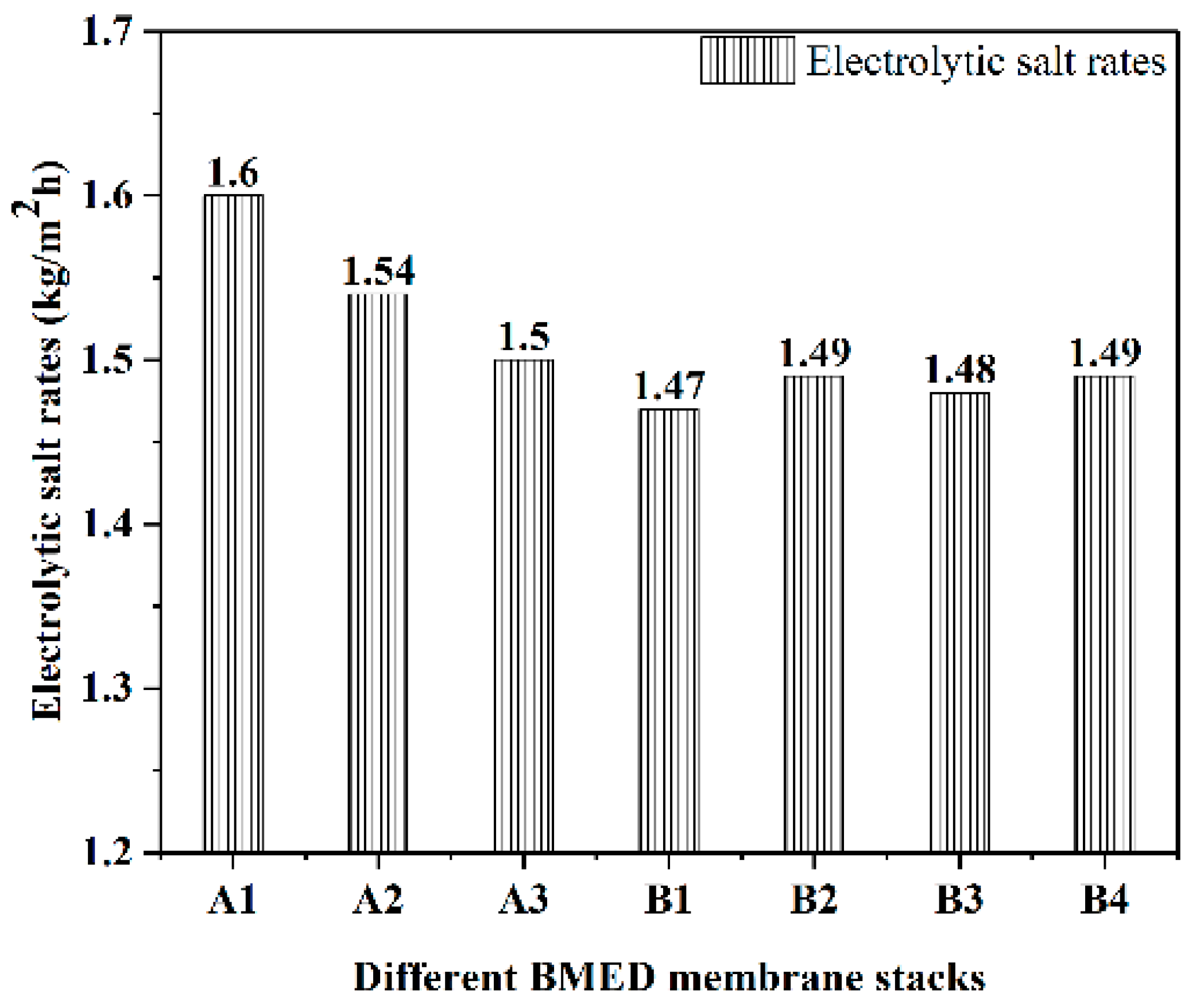

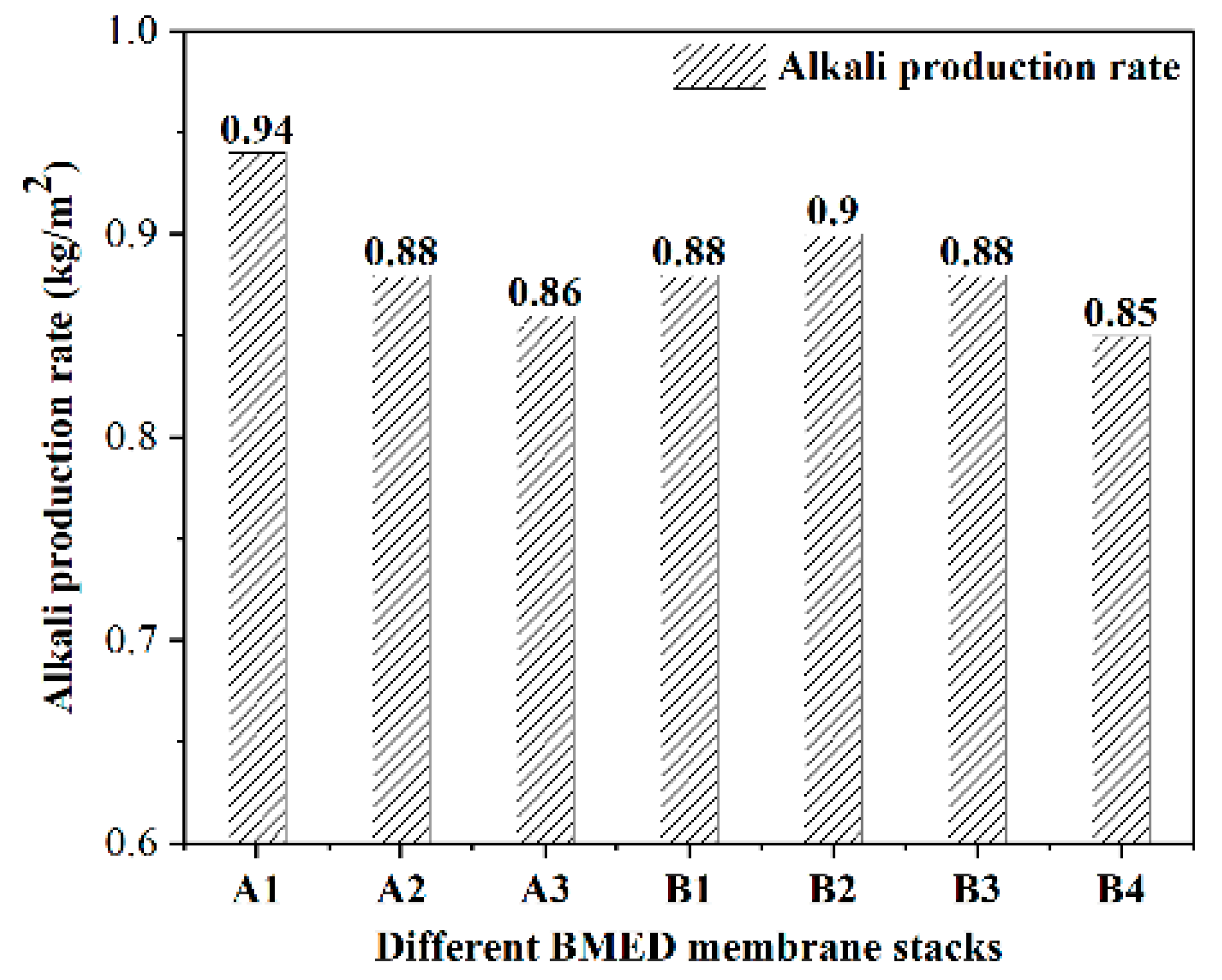
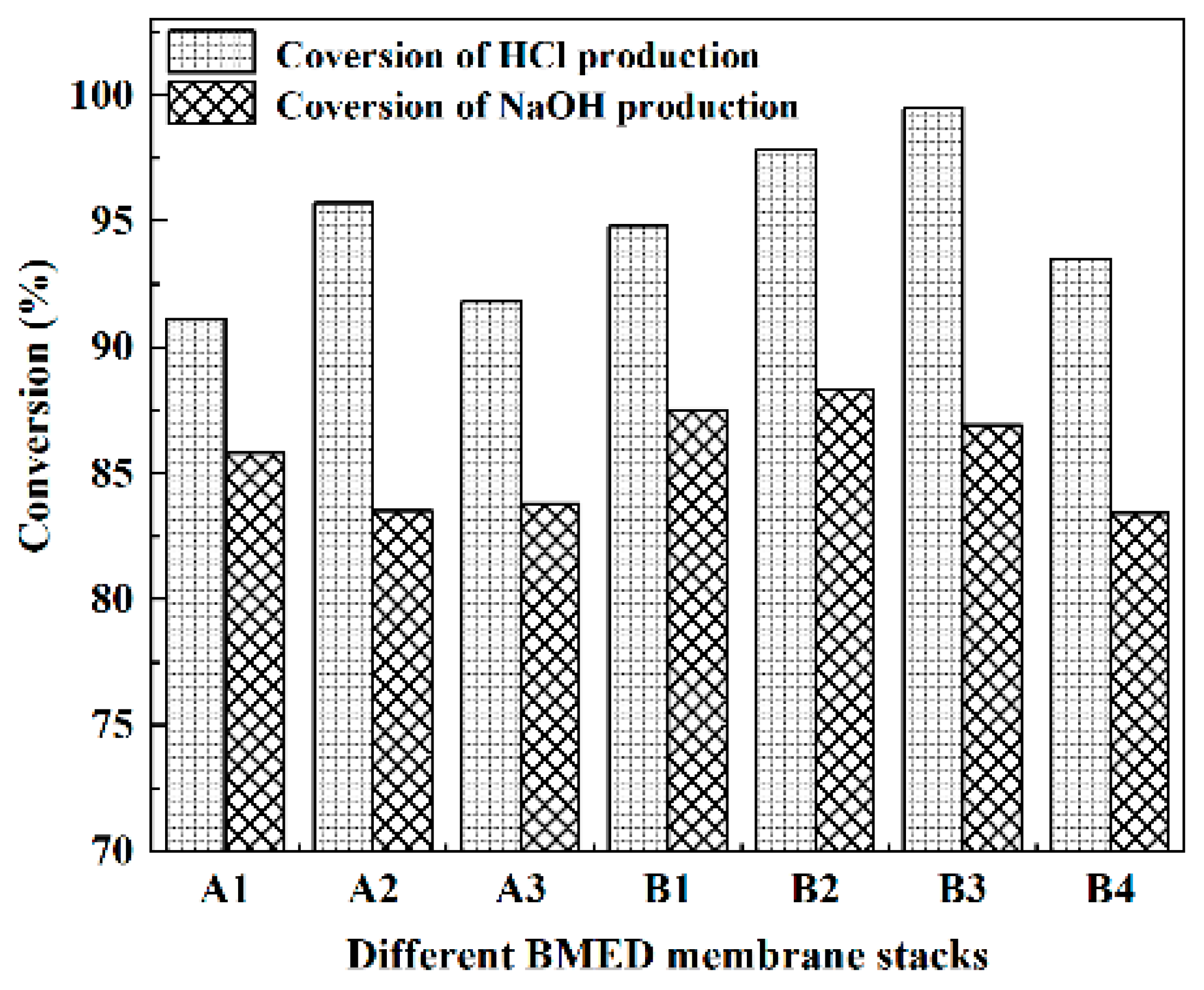

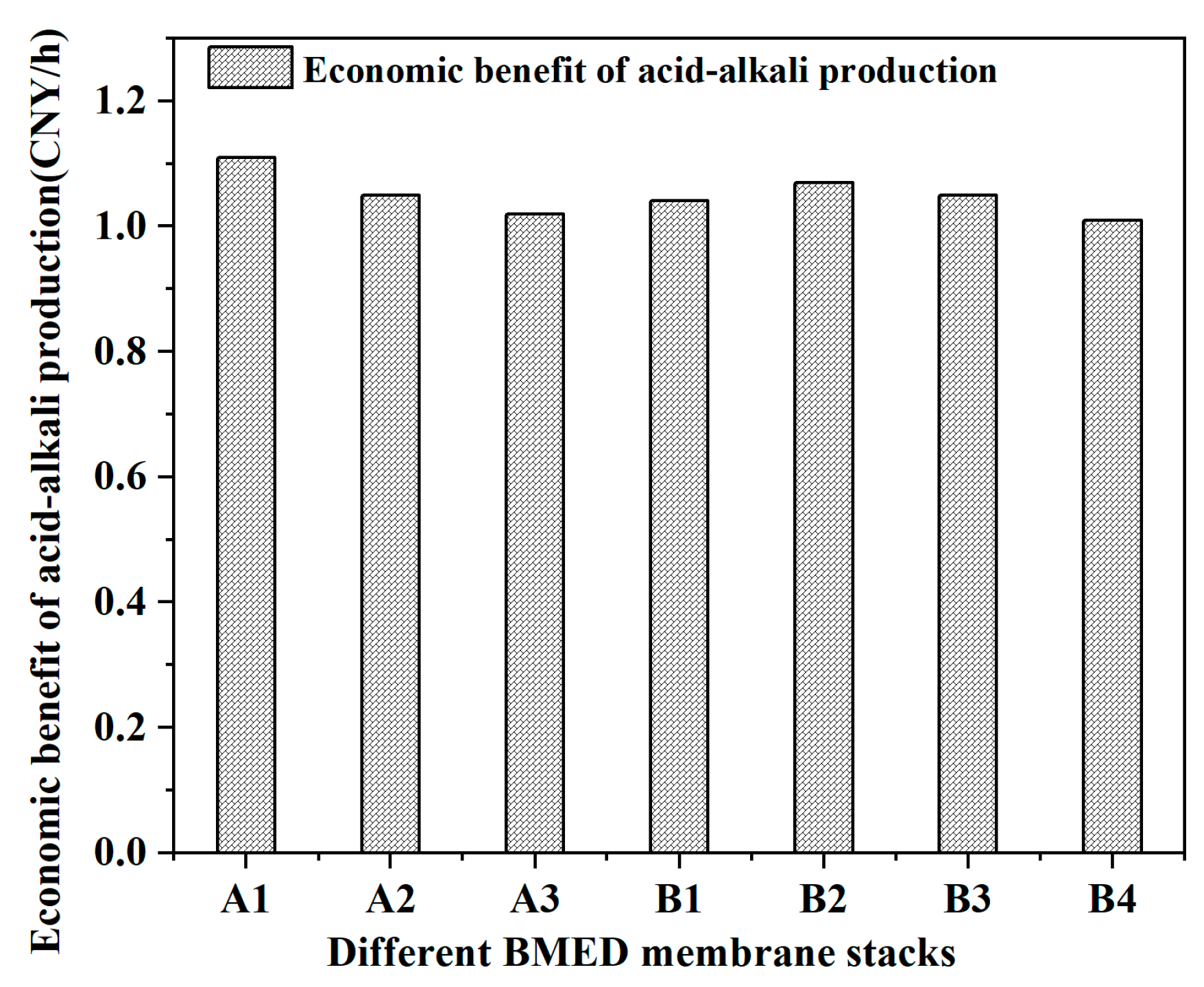

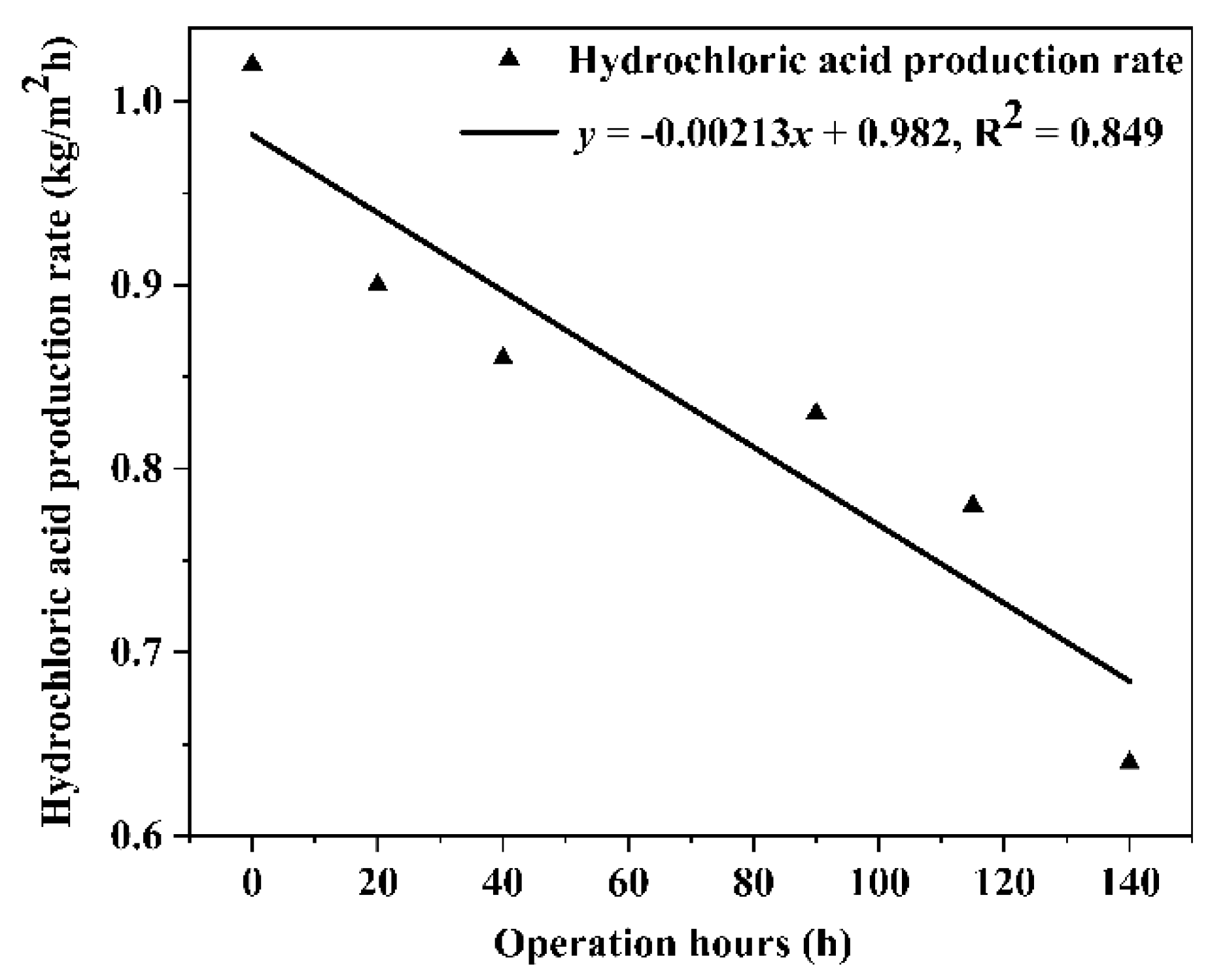
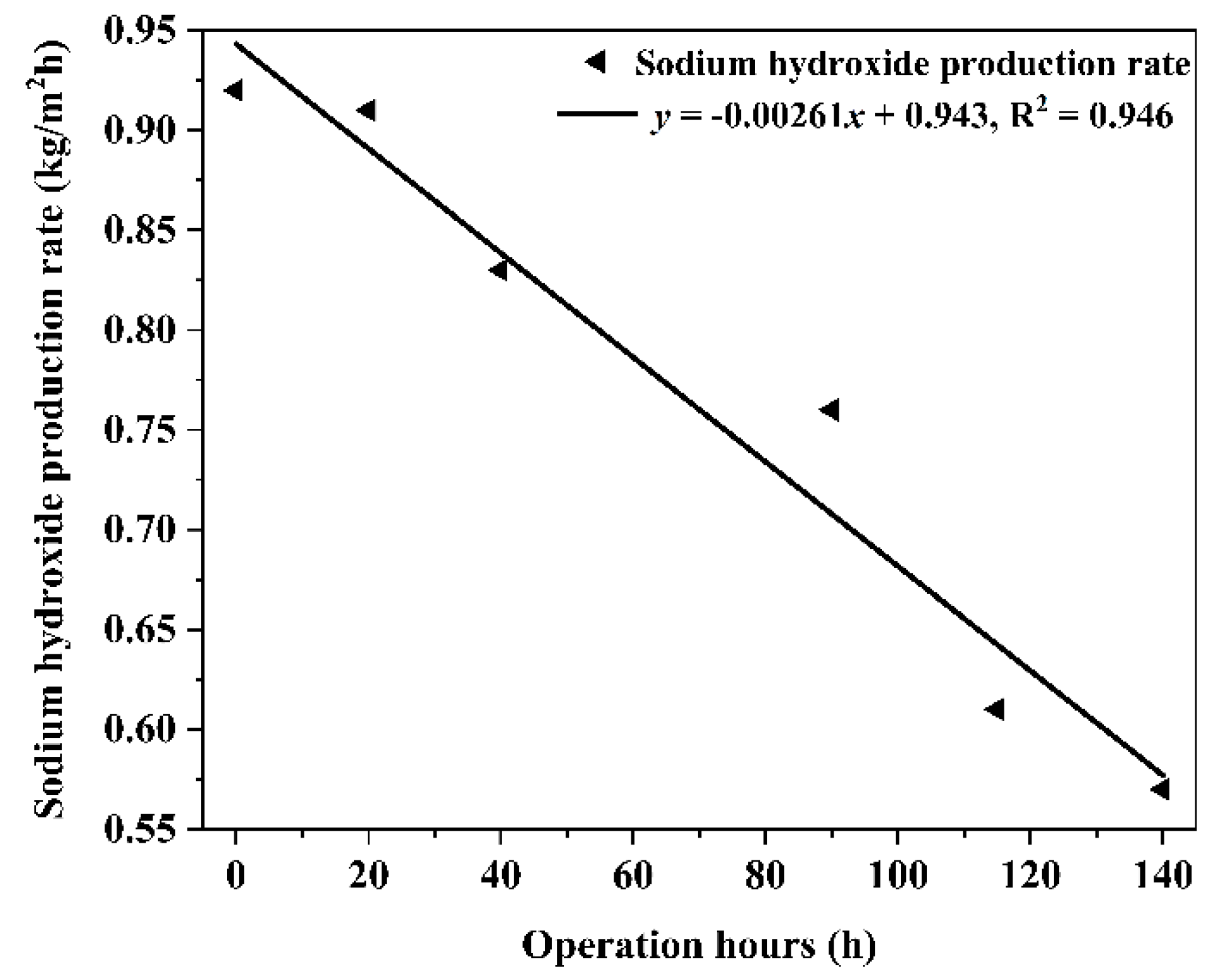



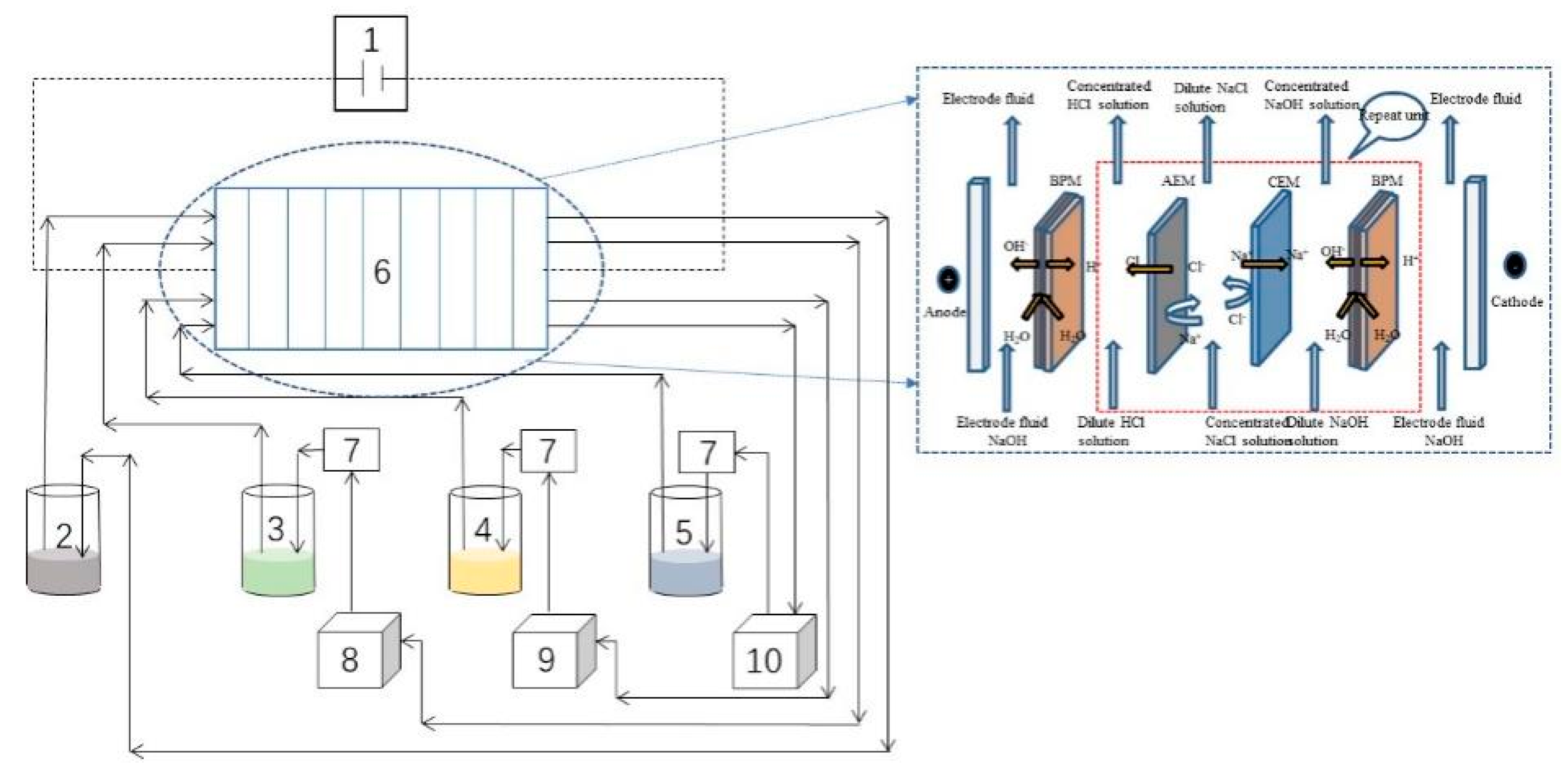
| Membrane Type | Thickness (mm) | Blasting Strength (MPa) | Resistance (Ω·cm2) | Operating pH | Washing pH | Operating Temperature (°C) |
|---|---|---|---|---|---|---|
| BPM (NEOSEPTA) | 0.22 | ≥0.4 | - | 0–14 | 0–14 | ≤40 |
| BPM(LANRAN-BP-2) | 0.28 | ≥1.0 | - | 0–14 | 0–14 | 25–40 |
| CEM (Type 1) | 0.21 | ≥0.4 | 4.5 | 0–14 | 0–14 | ≤60 |
| CEM (Type 2) | 0.28 | >0.5 | <8.0 | 0–14 | 0–14 | 25–60 |
| AEM (Type 1) | 0.11 | ≥0.15 | 2.6 | 0–8 | 0–8 | ≤40 |
| AEM (Type 2) | <0.21 | >0.5 | <3.8 | 0–14 | 0–14 | 25–60 |
| Membrane Type | Composition of the Membrane Stack | ||
|---|---|---|---|
| AEM | CEM | BPM | |
| A1 | Type 1 | Type 1 | NEOSEPTA Membrane |
| A2 | Type 2 | Type 2 | NEOSEPTA Membrane |
| A3 | Type 1 | Type 2 | NEOSEPTA Membrane |
| B1 | Type 1 | Type 1 | NEOSEPTA Membrane |
| B2 | Type 2 | Type 2 | NEOSEPTA Membrane |
| B3 | Type 1 | Type 1 | LANRAN-BP-2 |
| B4 | Type 2 | Type 2 | LANRAN-BP-2 |
Publisher’s Note: MDPI stays neutral with regard to jurisdictional claims in published maps and institutional affiliations. |
© 2022 by the authors. Licensee MDPI, Basel, Switzerland. This article is an open access article distributed under the terms and conditions of the Creative Commons Attribution (CC BY) license (https://creativecommons.org/licenses/by/4.0/).
Share and Cite
Lü, X.; Shao, S.; Wu, J.; Zhao, Y.; Lu, B.; Li, J.; Liang, L.; Tian, L. Recovery of Acid and Alkaline from Industrial Saline Wastewater by Bipolar Membrane Electrodialysis under High-Chemical Oxygen Demand Concentration. Molecules 2022, 27, 7308. https://doi.org/10.3390/molecules27217308
Lü X, Shao S, Wu J, Zhao Y, Lu B, Li J, Liang L, Tian L. Recovery of Acid and Alkaline from Industrial Saline Wastewater by Bipolar Membrane Electrodialysis under High-Chemical Oxygen Demand Concentration. Molecules. 2022; 27(21):7308. https://doi.org/10.3390/molecules27217308
Chicago/Turabian StyleLü, Xiangfei, Shuai Shao, Jinlong Wu, Yongguo Zhao, Bishuai Lu, Jieying Li, Linlin Liang, and Lei Tian. 2022. "Recovery of Acid and Alkaline from Industrial Saline Wastewater by Bipolar Membrane Electrodialysis under High-Chemical Oxygen Demand Concentration" Molecules 27, no. 21: 7308. https://doi.org/10.3390/molecules27217308





